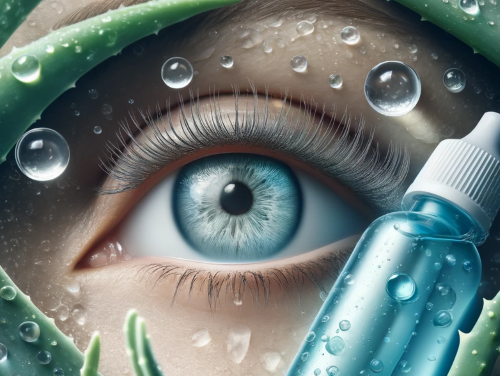
Introduction:
Sodium hyaluronate eye gel is a highly effective treatment option for individuals suffering from dry eye disease, a common condition characterized by insufficient lubrication on the surface of the eye. This can lead to irritation, redness, discomfort, and sometimes blurred vision. Sodium hyaluronate, a form of hyaluronic acid, is renowned for its exceptional water retention properties, making it an ideal ingredient in eye care products aimed at alleviating dry eye symptoms.

Key Features of Sodium Hyaluronate Eye Gel for Dry Eye Disease:
- High Moisturizing Efficiency: Sodium hyaluronate can hold up to 1,000 times its weight in water, providing superior hydration and maintaining moisture on the ocular surface for extended periods.
- Soothing Relief: The gel formulation offers immediate soothing relief from the burning and irritation associated with dry eyes, creating a protective layer that shields the eyes from environmental stressors.
- Enhanced Lubrication: By mimicking the natural lubricating properties of the eye’s tear film, sodium hyaluronate eye gel improves eye comfort, making it easier to carry out daily tasks without discomfort.
- Long-lasting Comfort: Unlike some other eye drops, sodium hyaluronate eye gels provide sustained relief, reducing the need for frequent application.
- Compatibility with Contact Lenses: Many sodium hyaluronate eye gels are safe to use with contact lenses, providing relief for lens wearers who often experience increased dry eye symptoms.
Applications of Sodium Hyaluronate Eye Gel:
- Daily Use for Dry Eye Relief: Ideal for individuals with chronic dry eyes looking for daily management of their symptoms.
- Post-Surgical Care: Often recommended after certain eye surgeries to promote healing and comfort during the recovery process.
- Environmental Protection: Useful for protecting the eyes from drying effects caused by wind, sun, pollution, and prolonged screen time.
Cases Reported of Sodium Hyaluronate Eye Gel for Dry Eye Disease:
Methods: A multi-center, open-label, uncontrolled clinical trial was conducted across various centers in Pakistan, involving 250 DED-diagnosed patients, with 240 completing the study. Patients were assessed for tolerability and safety through adverse event monitoring and underwent physical examinations at baseline, the 4th week, and the 8th week.
Results: The study population had an average age of 43.4 ±17.8 years, with a nearly even gender split. Initial symptoms included foreign body sensation (50.6%), itching (35.9%), burning (50.6%), watering (42.9%), photophobia (25.3%), and dryness (14.7%). By the 4th week, symptom prevalence slightly decreased, and by the 8th week, further reductions were observed in all symptoms.
Conclusion: Sodium hyaluronate Eye Gel shows promise as an effective treatment option for DED, demonstrating significant improvements in symptoms like foreign body sensation, itching, burning, watering, photophobia, and dryness.
Product Recommendations:
When selecting a sodium hyaluronate eye gel, it’s essential to choose products specifically designed for ophthalmic use and approved by relevant health authorities. Some products may also combine sodium hyaluronate with other beneficial ingredients like antioxidants or minerals to enhance the healing and protective effects. For more professional information, please check Stanford Chemicals (SCC).
Conclusion:
Sodium hyaluronate eye gel is a cornerstone in the management of dry eye disease, offering a scientifically backed, effective, and gentle solution for those seeking relief from this uncomfortable condition. Its hydrating properties not only soothe existing irritation but also help to prevent further moisture loss, ensuring the eyes remain lubricated and comfortable throughout the day. As with any eye care product, it’s advisable to consult with an eye care professional to ensure the selected product is appropriate for your specific needs and condition.
Reference:
[1] Saeed N, Qazi Z, H Butt N, Siddiqi A, Maheshwary N, Athar Khan M. Effectiveness of sodium hyaluronate eye gel in patients with dry eye disease: a multi-centre, open label, uncontrolled study. Pak J Med Sci. 2013 Jul;29(4):1055-8. doi: 10.12669/pjms.294.3487. PMID: 24353687; PMCID: PMC3817783.
